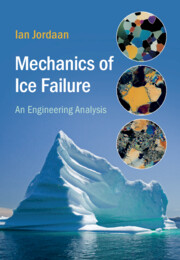Book contents
- Frontmatter
- Dedication
- Dedication
- Contents
- Preface
- Acknowledgments
- Part I Basics and Design for Compressive Ice Interactions
- Part II Theory of Time-Dependent Deformation and Associated Mechanics
- 6 Viscoelastic Theory and Ice Behaviour
- 7 Complex States of Stress and Triaxial Tests
- 8 Damage Analysis and Layer Formation
- 9 Fracture of Ice and Its Time-Dependency
- 10 Concluding Remarks
- Appendix A Précis of the Work of R. A. Schapery
- Appendix B Preparation of Laboratory Ice Test Samples
- References
- Index
8 - Damage Analysis and Layer Formation
from Part II - Theory of Time-Dependent Deformation and Associated Mechanics
Published online by Cambridge University Press: 10 February 2023
- Frontmatter
- Dedication
- Dedication
- Contents
- Preface
- Acknowledgments
- Part I Basics and Design for Compressive Ice Interactions
- Part II Theory of Time-Dependent Deformation and Associated Mechanics
- 6 Viscoelastic Theory and Ice Behaviour
- 7 Complex States of Stress and Triaxial Tests
- 8 Damage Analysis and Layer Formation
- 9 Fracture of Ice and Its Time-Dependency
- 10 Concluding Remarks
- Appendix A Précis of the Work of R. A. Schapery
- Appendix B Preparation of Laboratory Ice Test Samples
- References
- Index
Summary
The analysis of ice response to stress using finite elements is described, using multiaxial constitutive relationships, including damage, in a viscoelastic framework. The U-shaped relationship of compliance with pressure is part of this formulation. The results show that the layer of damaged ice adjacent to the indentor arises naturally through the formulation, giving rise to a peak load and subsequent decline. This shows that there can be “layer failure” in addition to failure due to fractures and spalling. Tests on extrusion of crushed ice are described together with a formulation of constitutive relationships based on special triaxial tests of crushed ice. The ice temperature measured during field indentation tests showed a drop in temperature during the upswings in load. This was attributed to localized pressure melting. Small scale indentor tests are described, which show clearly the difference between layer failure and spalling, as found using high-speed video and pressure-sensitive film. The question of scaling, as used in ice tanks, is addressed. Flexural failure can be scaled to some extent; scaling of high-pressure zones lies in the mechanics as developed in the book.
Keywords
- Type
- Chapter
- Information
- Mechanics of Ice FailureAn Engineering Analysis, pp. 135 - 168Publisher: Cambridge University PressPrint publication year: 2023



